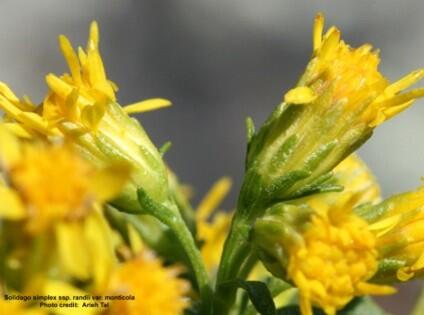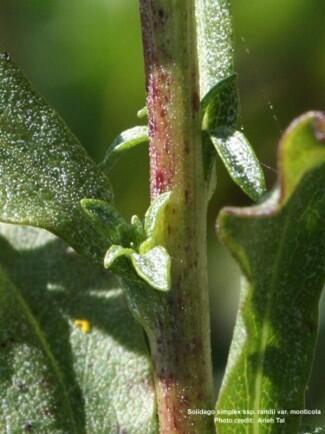- Scientific name: Solidago randii
- Species of Greatest Conservation Need (MA State Wildlife Action Plan)
Endangered (MA Endangered Species Act)
Description

Photo by Arieh Tal.
Rand’s goldenrod is a 1-9 dm (4-35 in) tall herbaceous perennial plant with a smooth stem and dense yellow flower clusters on ascending terminal and axillary branches. The basal rosette and lower stem leaves are the largest leaves. The leaves are progressively reduced in size higher on the stem. This member of the composite (Asteraceae) family grows in clusters arising from a spreading, persistent woody stem (caudex) near the ground surface. In Massachusetts, plants in exposed conditions are large, upright, have a robust inflorescence, and grow in dense clusters (with as many as 30-40 stems per cluster). Plants growing in the shade of the oak/heath forest are smaller, have a more delicate, sometimes nodding inflorescence, and have fewer stems per cluster.
Rand’s goldenrod stems are smooth (glabrous) except for a slight pubescence in the inflorescence. The basal and lower stem leaves are smooth, pointed, sparsely toothed, 5-10 cm (2-4 in) long and 0.5-1.6 cm (0.2-0.6 in) wide, widest above the middle, and tapered to the petiole. The upper stem leaves are smaller, narrower, and entire or slightly toothed. The plant’s flowers are on ascending terminal and axillary branches. The bright yellow flowers (with 7-10 rays per head) are densely crowded on short pedicels. The 12 to 28 floral bracts or phyllaries are dark-tipped, oblong to acute, and arranged in overlapping rows. The plant’s achenes are 2-2.6 mm (0.1 in) in length and densely hairy.
One feature that distinguishes Rand’s goldenrod from similar goldenrod species is the sticky, resinous exudates on the inflorescence when the plant is in bloom. In New England, Rand’s goldenrod grows on exposed ledges and rock crevices in mountainous regions.
Downy goldenrod (Solidago puberula) resembles Rand’s goldenrod, occupies similar habitat, and may hybridize with it. Downy goldenrod differs from Rand’s goldenrod in having pubescent stems and leaves, 24-28 sharply acute or long-pointed floral bracts, and no resinous substance in the inflorescence. Hairy goldenrod (Solidago hispida), a species extirpated in Massachusetts, superficially resembles Rand’s goldenrod but has densely hairy stems and leaves and smooth or only sparsely hairy achenes.
Life cycle and behavior
This is a perennial species.

Population status

Photo by Arieh Tal.
Rand’s goldenrod is listed under the Massachusetts Endangered Species Act as endangered. All listed species are protected from killing, collecting, possessing, or sale and from activities that would destroy habitat and thus directly or indirectly cause mortality or disrupt critical behaviors. MassWildlife’s Natural Heritage & Endangered Species Program database has 4 records from 1 county (Berkshire). All 4 records are within the last 25-year period.
Distribution and abundance
The documented range of Rand’s goldenrod extends from Nova Scotia southward to the Cumberland Plateau and river gorges of Tennessee, and west to Michigan and Minnesota. In the northeastern United States, the plant grows in rocky, high-elevation habitats. In Massachusetts, Rand’s goldenrod is present only in the Taconic Range of southwestern Berkshire County, which is its southernmost station in New England.

Distribution in Massachusetts. 1999-2024. Based on records in the Natural Heritage Database.
Habitat

Photo by Arieh Tal.
In Massachusetts, Rand’s goldenrod grows in rock crevices and on exposed ledges at high elevations (c.2000 ft) in southwestern Berkshire County. The bedrock where the plant occurs is granitic or schistose, and the soils are thin, dry, and acidic. The plants grow in full sunlight on rocky summits and also in partial shade in second-growth oak/heath forests. Plants associated with Rand’s goldenrod on exposed summits and ridgetops include red oak (Quercus rubra), scrub oak (Q. ilicifolia), black cherry (Prunus pensylvanica), black chokeberry (Aronia melanocarpa), bearberry (Arctostaphylos uva-ursi), Ppennsylvania sedge (Carex pensylvanica), hair-grass (Deschampsia flexuosa), Canada bluegrass (Poa compressa), three-toothed cinquefoil (Potentilla tridentata), and little bluestem (Schizachyrium scoparium). Associated plants in oak/heath forest include white oak (Q. alba), red oak, and red maple (Acer rubrum) in the canopy; witch hazel (Hamamelis virginiana) and mountain laurel (Kalmia latifolia) in the understory; and black huckleberry (Gaylussacia baccata) and lowbush blueberry (Vaccinium angustifolium) as low shrubs.
Healthy habitats are vital for supporting native wildlife and plants. Explore habitats and learn about conservation and restoration in Massachusetts.
Threats
Most of the plants are not threatened by human impacts, but part of one population is situated in rock crevices along a popular hiking trail. Trampling annually damages stems in this population. While Rand’s goldenrod here appears to require trailside conditions, the population is at risk of reduction and elimination from hiker traffic.
Conservation
As for many rare species, exact needs for management of Rand’s goldenrod are not known. The following comments are based on observations in Massachusetts. Rand’s goldenrod is restricted to ledges and rock crevices on a single ridge in the Taconic Range. This trailside population should be monitored and the trail at least temporarily relocated away from the plants if the population starts to decline. All active management of rare plant populations (including invasive species removal) is subject to review under the Massachusetts Endangered Species Act, and should be planned in close consultation with the MassWildlife’s Natural Heritage & Endangered Species Program.
References
Brumback, W.B,. and L.J. Mehrhoff. 1996. Flora Conservanda: New England. The New England Plant Conservation Program (NEPCoP) list of plants in need of conservation. Rhodora 98: 233-361.
Nesom, G.L. 1989. Solidago simplex (Compositae; Asteraceae), the correct name for Solidago glutinosa. Phytologia 67 (2): 155-157.
Semple, J.C., and G.S. Ringius. 1992. The Goldenrods of Ontario. University of Waterloo Biology Series, #36. Department of Biology, University of Waterloo, Waterloo, Ontario.
Contact
| Date published: | May 8, 2025 |
|---|